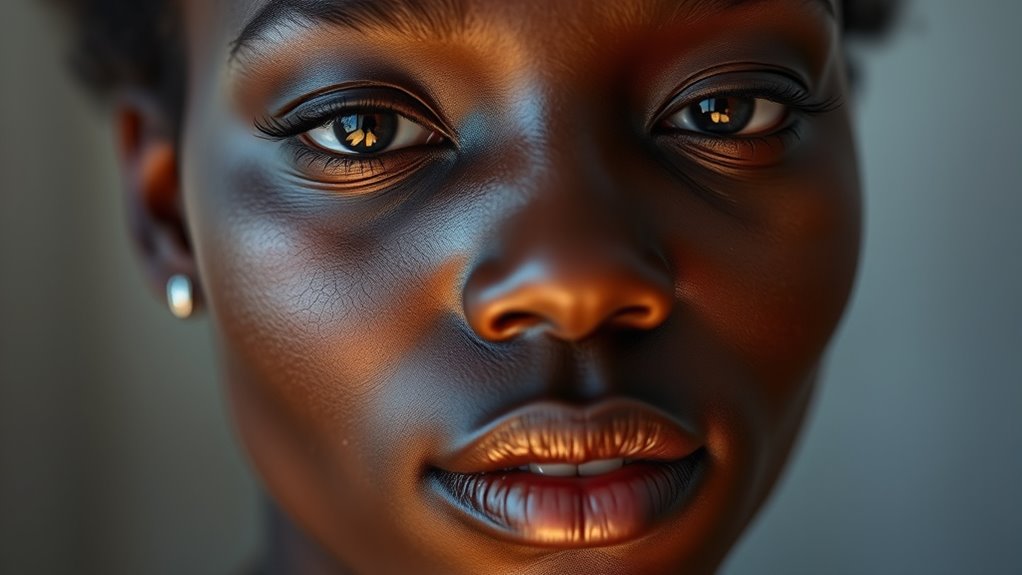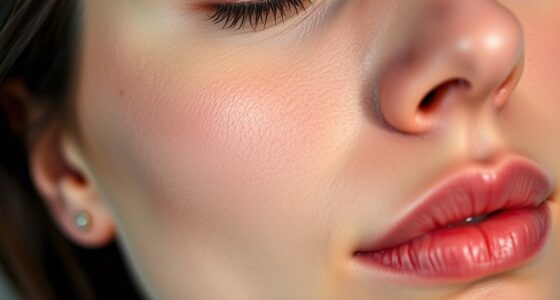When using LED therapy on darker skin tones, you should focus on wavelengths like red and near-infrared, which penetrate deeper and reduce the risk of pigmentation issues. It’s important to work with trained professionals who can customize treatment settings to your skin type, protect your skin from sun exposure, and follow proper aftercare. This helps guarantee safe, effective results while minimizing risks. To learn more about making LED therapy work best for your skin, keep exploring the details.
Key Takeaways
- Red and near-infrared wavelengths are safest and most effective for deeper skin penetration without pigmentation risks.
- Blue light is effective for acne but should be used cautiously on darker skin to prevent hyperpigmentation.
- Always consult trained professionals to tailor LED treatments and minimize risks like uneven pigmentation.
- Protect your skin from sun exposure before and after treatment with broad-spectrum sunscreen.
- Proper pre- and post-care enhances results and reduces the risk of adverse effects on darker skin tones.

Have you ever wondered if LED treatments are just as effective on darker skin tones? It’s a common question, especially as these therapies grow in popularity for skin rejuvenation, acne, and anti-aging. The truth is, LED light therapy works differently depending on your skin’s pigmentation, and understanding these differences can help you make informed choices. Unlike some treatments, LED therapy generally doesn’t pose a high risk of side effects for darker skin, but there are important considerations to keep in mind to maximize safety and results.
LED therapy involves exposing your skin to specific wavelengths of light, which penetrate at different depths and stimulate various cellular processes. For darker skin tones, the key is choosing the right wavelength. Red and near-infrared lights are often recommended because they penetrate deeper and are less likely to cause pigmentation issues. These wavelengths promote collagen production, reduce inflammation, and improve skin tone without risking hyperpigmentation. Blue light, which targets acne-causing bacteria, can also be used effectively, but it’s essential to ensure the treatment is tailored to your skin type and concerns.
Red and near-infrared lights are ideal for darker skin tones, promoting collagen and reducing inflammation safely.
However, you should be cautious with certain wavelengths, especially those in the shorter spectrum, like green or yellow light, which can sometimes trigger pigmentation changes in darker skin. It’s vital to work with a trained professional who understands how your skin reacts to different lights. They’ll adjust the treatment parameters to prevent adverse effects, such as hyperpigmentation or uneven skin tone. Also, always inform your provider about your skin type and any history of pigmentation issues, so they can customize the therapy accordingly.
Another important aspect is the preparation and aftercare. Protecting your skin from sun exposure before and after treatment minimizes the risk of hyperpigmentation. Using a broad-spectrum sunscreen is essential, even if you’re indoors most of the time, because UV rays can worsen pigmentation problems. Consistent skincare, including moisturizing and gentle cleansing, supports the healing process and enhances the benefits of LED therapy. Additionally, understanding the skin’s response to different wavelengths can help you better interpret results and adjust treatments over time.
Frequently Asked Questions
How Do LED Treatments Affect Melanin Levels in Darker Skin?
LED treatments generally don’t alter melanin levels in darker skin. Instead, they stimulate collagen production, reduce inflammation, and promote healing without affecting pigmentation. You should know that specific wavelengths, like red or near-infrared, are safer for darker skin tones because they minimize the risk of hyperpigmentation or hypopigmentation. Always consult a trained professional to ensure the treatment is tailored to your skin type and minimizes potential risks.
Are Certain LED Wavelengths Safer for Darker Skin Tones?
Yes, certain LED wavelengths are safer for darker skin tones. You should opt for wavelengths like red and near-infrared, as they penetrate deeper without increasing melanin production or causing hyperpigmentation. Avoid high-energy wavelengths like blue or UV light, which can be harsh and pose risks for darker skin. Always consult a professional to guarantee the treatment is suitable for your skin type and to minimize any adverse effects.
Can LED Therapy Cause Hyperpigmentation in Darker Skin?
Yes, LED therapy can cause hyperpigmentation in darker skin tones, especially if the treatment isn’t tailored properly. You should be cautious and consult with a skincare professional experienced with darker skin. They can recommend the right wavelengths and treatment plans to minimize risks. Always inform your provider about your skin type, and avoid excessive exposure to prevent unwanted pigmentation changes. Proper guidance helps guarantee safe, effective results.
How Long Does It Take to See Results on Darker Skin?
You can typically see results from LED therapy on darker skin within 4 to 8 weeks, but it varies based on your skin condition and treatment frequency. Consistent sessions are key, and some people notice improvements sooner, especially with targeted treatments. Keep in mind that individual responses differ, so stay patient and follow your provider’s recommendations to optimize results and minimize risks like hyperpigmentation.
Are There Specific LED Devices Recommended for Darker Skin Tones?
If you have darker skin tones, look for devices like the Tria Beauty Age-Defying Laser, which is FDA-approved for various skin types. For example, a woman with darker skin saw improvements after consistent use over several months. You should choose devices with adjustable settings and clinical backing. Always consult a dermatologist before starting treatments to guarantee safety and effectiveness tailored to your skin.
Conclusion
As you embrace the glow of LED treatments on darker skin tones, you might notice how the lights subtly dance across your skin, revealing a radiant confidence you didn’t realize was there. It’s like catching a glimpse of sunlight through a window—unexpected yet perfectly timed. When you understand the nuances, those gentle beams become allies in your skincare journey, illuminating the path to healthier, more vibrant skin. Sometimes, the right light at the right moment makes all the difference.









